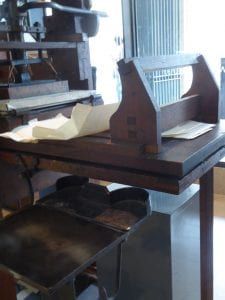
Naomi’s Photos
Are you familiar with those reading comprehension exercises in which students are required to read the title of the passage, then copy the sentence from the text which answers the question in the title?
Well, if this post were such an exercise, here’s the sentence you would need to copy:
“I don’t know”.
While I am most certainly learning a whole lot of other things while trying to answer this question, the digital vs paper issue actually matters and cannot be ignored.
I’ve been working on creating short homework tasks for my mixed level tenth-grade students focusing on vocabulary. Since my students are Deaf and hard of hearing, their exposure to English as a foreign language outside of the classroom is severely limited. In addition, there is never enough time inside the classroom to provide sufficient repeated exposure of all the vocabulary items students need to know

Naomi’s Photos
Well, it seems that the issue of supplying sufficient repeated exposure to vocabulary items is a general one. According to Penny Ur’s article “Multiple review and vocabulary acquisition through reading “ teachers must make the most of the limited time available by focusing on tasks that challenge the students to actively remember a word’s meaning and produce it, as opposed to just recognizing it. Penny Ur , in a teacher-friendly way, cites research and explains how such activities, known as “retrieval activities” require fewer encounters with a word before a student can claim the word for herself/himself. The short article is full of practical suggestions.
So, “retrieval activities” are the way to go, right?
But I’m also trying to combine what I learned from John F. Fanselow’s book “Small Changes in Teaching, Big Results in Learning”, about how multiple readings of the same text promote the development of reading comprehension skills, vocabulary acquisition, syntax and more.
And I had the perfect text to work with.

Kevin Stein, in Japan, wrote (and generously posted!!) a series of short stories for teenagers, which are composed almost completely of vocabulary items from our mandatory word list. The vocabulary in the stories is mainly from the elementary level word list (band one) with a few words from the two more advanced levels. With Kevin’s permission, here is a copy of the story “How to Float” and an additional color-coded copy with vocabulary items marked according to level.
How to Float Color Copy– Kevin Stein
Here is the link to the Quizlet word list of the vocabulary items in the story, along with translations into Hebrew: https://quizlet.com/_6yv8lr
I began by giving the students homework tasks on paper. The students got the story in small sections, a few sentences at a time, with letters and words missing. They were required to complete the missing information with the help of their Quizlet list. The students then had to answer four simple questions about themselves that used vocabulary items from those sentences. The questions were not about the text.
*** You can find the first three worksheets at the end of this post.

Naomi’s Photos
I chose to use paper – as an old-timer I still tend to believe that there is a connection between hand movement and activating the brain. In addition, when creating tasks to be given on paper I did not have to worry about the copy/paste issue, which would have defeated a significant part of the purpose of the tasks – the students pay attention to every single letter making up the missing words.
The immediate benefit of using paper for the tasks took me by surprise – it taught the students how to use Quizlet, both on the technical level (now they know the word list can be arranged alphabetically, for example) and they also began to realize that when I give a Quizlet list it actually does help do the task on hand.
On the other hand, all the familiar disadvantages of giving homework tasks on paper began surfacing within a week. Besides the inconvenience of photocopying the tasks, keeping track of who got the worksheets and who was absent, it was a “great way” to quickly get to know which of my new 10th grade students copy homework from which students (it was easy to spot).

Naomi’s Photos
So, moving on to digital homework …
Sending a link to a Google Form via WhatsApp to my class broadcast list (not a group!!!) is easy to do. No photocopying, no absentee issue. It also enabled me to continue with the tasks on two different levels without it being obvious to other students that there is a difference. Best of all, the copying of homework doesn’t seem to be an issue anymore as the tasks require active typing of words. Theoretically, they could copy but now it takes real effort (as compared to a printed worksheet). With Google Forms, I get the answers directly, nicely ordered in columns.
However…
- I don’t know if the retention of vocabulary is better on handwritten tasks and the students are missing an opportunity.
- I don’t want the students to write sentences using Google and paste them into the homework task. So, as far as I can see, I’m limited to two types of tasks – completing missing letters in words (Th_re a_e t_o s_ops…) and rewriting sentences that have been written with no spaces (Therearetwoshopsand…)
- I have a student who doesn’t have a working phone and doesn’t know when she’ll get one that works. I have two students that send WhatsApp messages and use Instagram but are otherwise totally befuddled by doing anything like comparing words in the Quizlet list to a task open in another “window” on their phone (other students were happy with the shift to digital!).
- NOTE: I’m talking about phones because a significant number use their cell phones for everything and do not have working computers at home.
Yes, yes, I know I’m a Special Ed teacher with small classes. But preparing both a digital form and a printed version for every task, at two levels is a bit much… AARGH!
So, which is better for vocabulary retrieval tasks – paper or digital?
- – – – – – – – – – – – – – – – – – – – – – – – – – – – – – – – – – – – – – – – – – – – – – – – – – – –
Part One – worksheet one – How To Float first para exercise
Part Two – worksheet two – How to float week two full copy
Part Three – worksheet three – How To Float Week three
I love how you are able to find connections between the things you read and learn! My junior high school students are very focused on vocabulary these days because they are now studying English in school, and that requires a lot of memorization and translation. I’ve found that digital and paper complement each other. Quizlet provides low-stress contact time with the words, and lots of repetition. But, it doesn’t really help with knowing how to use the new words in different contexts. Two weeks ago we tried a really simple matching game (e.g., study/studies) with the verbs that are repeated a lot in their book. They turned over two cards and made sentences with each verb. This is their first year of serious English study in schools, and they need a lot of practice with sentence structure and word order. I was really impressed with them trying out different vocabulary and patterns in their sentences! And when I checked the next week, they remembered those new words, so the simple paper activity was a winner for me. I was surprised when they asked to do it again the next week, but they said it was really helpful and they were more confident (about using those words, anyway) in their school English class.
Barbara,
Many thanks for your insightful comments! I certainly agree about practice needed with sentence structure /formation.
There is so much that can be done with simple pieces of paper!
Just to clarify, Quizlet in this context isn’t used as a “going digital” method, but rather as the online dictionary tailored for this activity.
Using this story is meant to provide additional engagement /exposure with vocabulary items beyond the lessons. The students are filling in missing letters and whole words (later whole sentences ) of the same story to internalize it. They can do that on paper or through a Google Form sent by WhatsApp. Doing those kinds of exercises in each manner has advantages and disadvantages. That’s where I am now.
To be continued!
Naomi
I have always encouraged the use of paper in educational and academic stuff. However, with the change in technology, digital media has grown too much to be kept away from academic stuff. Students should be encouraged to use papers to write notes, answers, and use papers to actually correct their vocabulary too. Until and unless they don’t write the words themselves on a piece of paper, they don’t realize the need to learn them. Also, digital media is necessary to encourage a fair medium for students to actually search tasks for themselves, create notes, however, copy-pasta should be avoided as much as possible. In today’s modern world, we can’t totally be dependent on one form of media for vocabulary.
Thank you, Sanjeet.
Excellent points, Sanjeet!
We need both the digital and the paper – the tricky part is finding a balance that the teacher can integrate in a sane way without going nuts!
Thanks for your comments!
Naomi